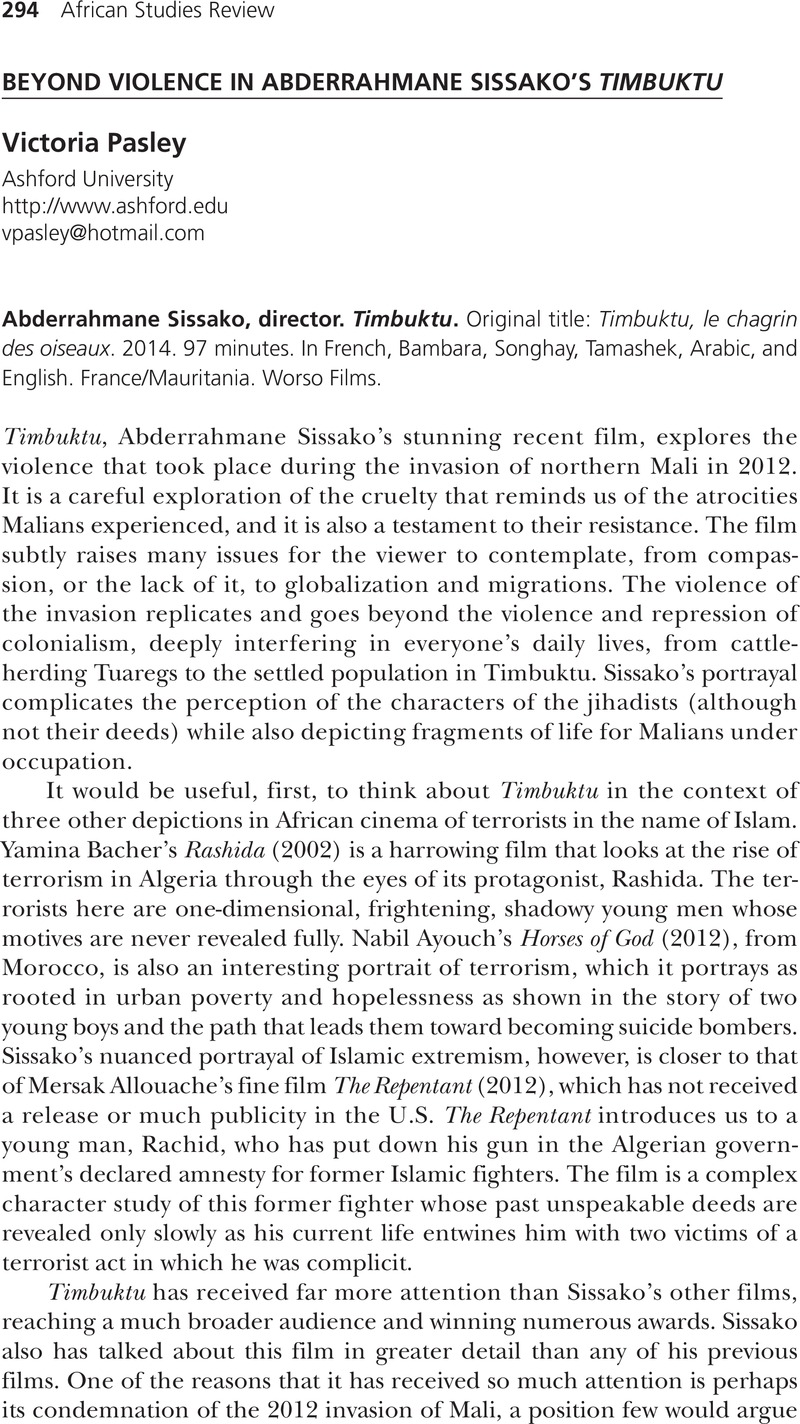No CrossRef data available.
Article contents
BEYOND VIOLENCE IN ABDERRAHMANE SISSAKO’S TIMBUKTU - Abderrahmane Sissako, director. Timbuktu. Original title: Timbuktu, le chagrin des oiseaux. 2014. 97 minutes. In French, Bambara, Songhay, Tamashek, Arabic, and English. France/Mauritania. Worso Films.
Review products
Abderrahmane Sissako, director. Timbuktu. Original title: Timbuktu, le chagrin des oiseaux. 2014. 97 minutes. In French, Bambara, Songhay, Tamashek, Arabic, and English. France/Mauritania. Worso Films.
Published online by Cambridge University Press: 19 December 2016
Abstract
An abstract is not available for this content so a preview has been provided. Please use the Get access link above for information on how to access this content.

- Type
- FILM REVIEW ESSAYS
- Information
- Copyright
- Copyright © African Studies Association 2016
References
References
Blue Is the Warmest Color
. 2013. Directed by Abdellatif Kechiche. France: Quat’sous Films.Google Scholar
Horses of God
. Directed by Nabil Ayouch. Morocco/France: Ali’n Productions.Google Scholar
La Vie sur terre
. 1998 Directed by Abderrrahmane Sissako. Mauritania/Mali/France Centre National de la Cinématographie (CNC).Google Scholar
Aguilar, Carlos. 2015
“Promoting Tolerance: Abderrahmane Sissako on ‘Timbuktu’ and a Different Kind of Islam.”
IndieWire, February 19. http://www.indiewire.com.Google Scholar
Bartlet, Olivier. 2002. “Interview with Abderrahmane Sissako.” Africultures 54. www.africultures.com.Google Scholar
Cinezik.fr. 2014. “Amine Bouhafa: Timbuktu d’Abderrahamane Sissako.” May 24. http://www.cinezik.org.Google Scholar
Diawara, Manthia. 2015
“Frames of Resistance: Manthia Diawara on the Films of Abderrahmane Sissako.”
Artforum International
53 (5).Google Scholar
Doostdar, Alireza. 2014. “How Not to Understand Isis.” Martin Marty Center for the Advanced Study of Religion, University of Chicago Divinity School. October 2. https://divinity.uchicago.edu.Google Scholar
Festival de Cannes. 2014. “Press Conference—Abderrahmane Sissako: There Is a Complex Side to Each Human Being.” May 15. http://org-www.festival-cannes.com.Google Scholar
Leigh, Danny. 2015
“Timbuktu’s Director: Why I Dared to Show Hostage-Taking Jihadis in a New Light.”
The Guardian, May 28.Google Scholar
Maheshwari, Laya. 2015. “Meet the Filmmaker Who Got a Ten-Minute Standing Ovation at Cannes.” Vice Media, January 7. http://www.vice.com.Google Scholar
Mbembe, Achille. 2015. “Achille Mbembe: The Value of Africa’s Aesthetics.”
Mail and Guardian, May 15. http://mg.co.za.Google Scholar
Niedan, Christian. 2013. “Camera Q and A: Abserrahmane Sissako on the Early Films of Sembène.”
Camera, May 13. http://camerainthesun.com.Google Scholar
Silverman, Rena. 2015. “Director of Oscar-Nommed ‘Timbuktu’ Found a Star in a Refugee Camp.”
Goats and Soda, National Public Radio, February 22. http://www.npr.org.Google Scholar
Thomas, Stephen W. 2014. “Languages, Globalization, and African Film Language: Bamako by Sissako.” April 13. https://filmandmedia.net.Google Scholar
Watershed. 2015. “Interview with Abderrahmane Sissako.” Conversations about Cinema, May 28. http://www.conversationsaboutcinema.co.uk.Google Scholar
Woodson, Alex. 2015. “Ethics on Film: Discussion of ‘Timbuktu.’” Carnegie Council for Ethics on International Affairs, February 25. http://www.carnegiecouncil.org.Google Scholar
Blue Is the Warmest Color
. 2013. Directed by Abdellatif Kechiche. France: Quat’sous Films.Google Scholar
Horses of God
. Directed by Nabil Ayouch. Morocco/France: Ali’n Productions.Google Scholar
La Vie sur terre
. 1998 Directed by Abderrrahmane Sissako. Mauritania/Mali/France Centre National de la Cinématographie (CNC).Google Scholar
Aguilar, Carlos. 2015
“Promoting Tolerance: Abderrahmane Sissako on ‘Timbuktu’ and a Different Kind of Islam.”
IndieWire, February 19. http://www.indiewire.com.Google Scholar
Bartlet, Olivier. 2002. “Interview with Abderrahmane Sissako.” Africultures 54. www.africultures.com.Google Scholar
Cinezik.fr. 2014. “Amine Bouhafa: Timbuktu d’Abderrahamane Sissako.” May 24. http://www.cinezik.org.Google Scholar
Diawara, Manthia. 2015
“Frames of Resistance: Manthia Diawara on the Films of Abderrahmane Sissako.”
Artforum International
53 (5).Google Scholar
Doostdar, Alireza. 2014. “How Not to Understand Isis.” Martin Marty Center for the Advanced Study of Religion, University of Chicago Divinity School. October 2. https://divinity.uchicago.edu.Google Scholar
Festival de Cannes. 2014. “Press Conference—Abderrahmane Sissako: There Is a Complex Side to Each Human Being.” May 15. http://org-www.festival-cannes.com.Google Scholar
Leigh, Danny. 2015
“Timbuktu’s Director: Why I Dared to Show Hostage-Taking Jihadis in a New Light.”
The Guardian, May 28.Google Scholar
Maheshwari, Laya. 2015. “Meet the Filmmaker Who Got a Ten-Minute Standing Ovation at Cannes.” Vice Media, January 7. http://www.vice.com.Google Scholar
Mbembe, Achille. 2015. “Achille Mbembe: The Value of Africa’s Aesthetics.”
Mail and Guardian, May 15. http://mg.co.za.Google Scholar
Niedan, Christian. 2013. “Camera Q and A: Abserrahmane Sissako on the Early Films of Sembène.”
Camera, May 13. http://camerainthesun.com.Google Scholar
Silverman, Rena. 2015. “Director of Oscar-Nommed ‘Timbuktu’ Found a Star in a Refugee Camp.”
Goats and Soda, National Public Radio, February 22. http://www.npr.org.Google Scholar
Thomas, Stephen W. 2014. “Languages, Globalization, and African Film Language: Bamako by Sissako.” April 13. https://filmandmedia.net.Google Scholar
Watershed. 2015. “Interview with Abderrahmane Sissako.” Conversations about Cinema, May 28. http://www.conversationsaboutcinema.co.uk.Google Scholar
Woodson, Alex. 2015. “Ethics on Film: Discussion of ‘Timbuktu.’” Carnegie Council for Ethics on International Affairs, February 25. http://www.carnegiecouncil.org.Google Scholar


